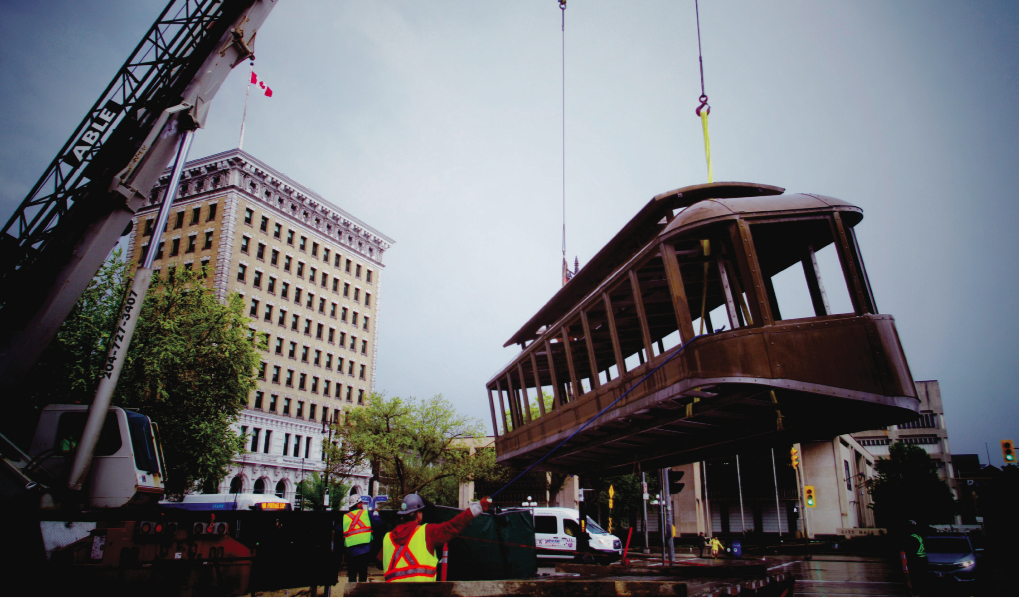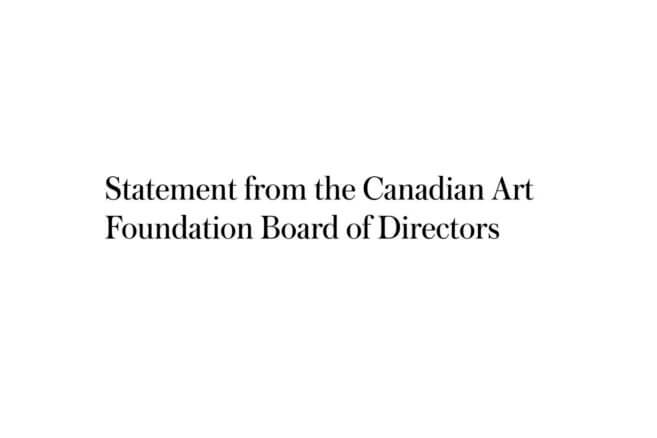Public Art
There’s a new public artwork in Winnipeg dedicated to the Bloody Saturday of the city’s 1919 General Strike. The artwork will be revealed on June 21, the 100th anniversary of Bloody Saturday. On that date 100 years ago, WWI veterans were protesting the arrest of strike leaders. Next, “a streetcar driven into the crowd by strikebreakers was rocked off its tracks and torched, triggering the deaths of two protesters and the hospitalization of 27 others at the hands of mounted police and private militia.” The new public artwork by Bernie Miller and Noam Gonick is a “a steel and glass ghost of the original trolley—tipped and sunken into the pavement adjacent to the Main Street site of the incident.” (press release)
Edmonton’s Indigenous art park—ᐄᓃᐤ (ÎNÎW) River Lot 11∞—has received an international honour. The park is among 50 public art projects worldwide recognized this year by the Americans for the Arts Public Art Network Year in Review program. The unique park features permanent artworks by Amy Malbeuf, Tiffany Shaw-Collinge, Duane Linklater, Jerry Whitehead, Marianne Nicolson and Mary Anne Barkhouse, all curated by Candice Hopkins. (press release)
Banners in Toronto are honouring missing and murdered Indigenous women. “In Allan Gardens, 20-foot-tall charred cedar logs hold 13 large red banners aloft. Visitors can walk underneath them,” NOW Toronto reports of the project “Red Embers.” “The banners are designed by 15 Indigenous women artists and dedicated to Missing and Murdered Indigenous Women and Girls (MMIWG).” Artists include Kristen Auger, Annie Beach, Hillary Brighthill, Hannah Claus, Sarah Biscarra Dilley, Rosalie Favell, Adrienne Greyeyes, Lido Pimienta, Louise Solomon, Rolande Souliere, Eladia Smoke and Janelle Wawia. The project was developed by Larissa Roque, Tiffany Creyke and Lisa Rochon. (NOW Toronto)
Is your fountain is too big for a public park? Cut part of it off. That’s the witty strategy used by Claude Cormier in the recent relaunch of Dorchester Square in Montreal. The fountain he and his team designed for the renewed park was slightly too large in diameter, so they seemingly sliced a third or so of it off, and stuck a fake woodpecker on the back. (TVA Nouvelles)
Indigenous Art on Screen
The NFB is making progress on its Indigenous Action Plan. In the second year of the plan, there’s “a slate of 40 Indigenous-led works in development, production or recent release—while delivering on a commitment to devote a minimum of 15% of its production spending on Indigenous works, one year ahead of schedule.” The productions include Tasha Hubbard’s award-winning nîpawistamâsowin: We Will Stand Up and Michelle Latimer’s The Inconvenient Indian, based on the Thomas King book of the same name. (press release)
Indigenous film organizations are getting a boost from Netflix. “Netflix has announced new partnerships with three Indigenous cultural organizations in Canada to help foster and develop screen talent,” CBC reports. “The partnerships with imagineNATIVE, the Indigenous Screen Office, and Wapikoni Mobile were revealed [last week] at the Banff World Media Festival.” (CBC)
International Connections
Some Canadians are in the next Istanbul Biennial. Rebecca Belmore and Ambera Wellmann are among the 57 artists and collectives hailing from 26 countries that are participating in the next event. This year’s biennial, which runs September 14 to November 10, is curated by Nicolas Bourriaud. (Artnews)
There’s an initiative bringing Indigenous artists to Edinburgh. Indigenous Contemporary Scene “is bringing a group of Indigenous artists from across Kanata to Edinburgh this August to present a program of live arts across the city’s famous arts festivals,” says press materials. Among the creators featured are Tomson Highway and Cherish Violet Blood. (via email)
At least a few Canadians shone at Art Basel. According to Artnet’s price check, Steven Shearer’s painting Birdy Boy (2019) sold for $320,000 at Galerie Eva Presenhuber’s booth, while two photoworks by Ian Wallace sold for $11,000 each at Parra & Romero’s booth. Montreal blue-chip dealer Landau Fine Art was also highlighted in Artnet’s article “7 of the Best Works At Art Basel.” That post noted that “One of the most affecting masterworks of the fair can be found in the darkened enclave of Landau Fine Art’s stand, where this painting shows the softer side of the tormented, often unsparing Giacometti. One of only a dozen or so portraits that he made of his mistress and muse Caroline—a demimondaine whose full name is unknown—the canvas goes tender where the artist often goes tough.” The work, Caroline (1963), was valued at $18.5 million. (Artnet, Artnet)
Institutional Shifts
The City of Saskatoon wants city council to be involved in the selection of the leader for three city-controlled corporations—including Remai Modern. “The chief executive officers for Remai Modern, TCU Place and SaskTel Centre are currently chosen solely by the board of directors for each group,” CBC reports. “Now the city is recommending the creation of a CEO recruitment and performance committee for each of the three corporations. Each committee would include at least one or more city councillors, with other seats taken up by board members.” The proposal follows accusations of city interference by some departing Remai board members. (CBC)
A new toolkit is out to make the design of arts spaces more accessible. ArtsBuild Ontario has just released “Accessibility in Creative Spaces: A Toolkit for Ontario Arts Organizations.” The toolkit focuses on meeting legal guidelines as well as experiential accessibility, including how arts organizations are going beyond the built environment to offer inclusive spaces. (Akimbo)
Sudbury’s Galerie du Nouvel Ontario is moving house, with a parade. After 22 years at 174 Elgin, the gallery is inviting anyone and everyone, on June 28, to join them in dismantling Patrick Cruz’s current exhibition at that space and bringing it in a “performative parade” to the new space at 54 Elgin. (press release)
Dark Days
All OCAD University buildings were closed Tuesday due to a bomb threat. Calls received by the Toronto Police Tuesday morning said four post-secondary institutions were at risk: OCAD U, Ryerson, Humber College and George Brown College. Not all institutions closed all their buildings, but OCAD did so as a precaution, and to allow police to investigate. The school was reopened Wednesday. (CBC)
Loop Gallery in Toronto is closing—kind of. “For 10 years, 1273 Dundas West was our home—unfortunately, that time is coming to an end with the close of our current shows on June 23,” says an email from the gallery. “After that, we’ll be living a nomadic existence, at least for the time being.” The gallery is artist-membership run. (via email)
Remembering Megan Bice. Bice, a former curator at the McMichael Canadian Art Collection, passed away June 6 following a 10-year struggle with dementia. “Ms. Bice came to the McMichael in the late 1980s and developed a national reputation as an intelligent, sometimes audacious curator,” the Globe and Mail wrote when she resigned in 2002. (Toronto Star, Globe and Mail)

 The new public artwork Bloody Saturday by Bernie Miller and Noam Gonick as it was being installed in Winnipeg. The artwork references a famous photograph of a tipped trolley during the 1919 General Strike. Photo: Courtesy Winnipeg Arts Council.
The new public artwork Bloody Saturday by Bernie Miller and Noam Gonick as it was being installed in Winnipeg. The artwork references a famous photograph of a tipped trolley during the 1919 General Strike. Photo: Courtesy Winnipeg Arts Council.




